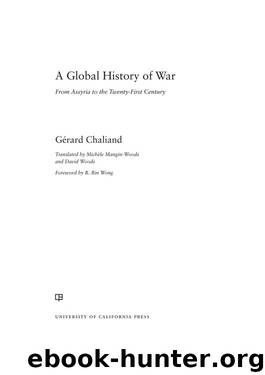A Global History of War: From Assyria to the Twenty-First Century by Gérard Chaliand

Author:Gérard Chaliand [Chaliand, Gérard]
Language: eng
Format: epub
ISBN: 9780520283602
Publisher: University of California Press
Published: 2014-11-17T08:00:00+00:00
AFTER GENGHIS KHAN
In the absence of primogeniture, battles over succession occurred frequently in both nomadic and sedentary societies, as will be seen in the Ottoman Empire. Because uncles, brothers, and sons could all claim the throne, the death of a sovereign often led to civil war. Genghis Khan had therefore specified who was to succeed him.
At the death of Genghis Khan (1227), the Mongol Empire included all North Asia, northern Persia and Afghanistan, and northern China. His empire was nominally inherited by his chosen heir, his second son, Ögedei. Ögedei, besides his title of Great Khan, received Dzungaria. Following tradition, parts of the empire were divided between his other sons; Chagatai received Transoxiana, Jochi took the western part of the empire, and the youngest son, Tolui, received Mongolia. After Ögedei’s death, the empire passed first to his eldest son, Güyük, then to a leader from a new clan, Möngke. The empire remained unified until 1259.
The different countries of this empire were connected by a system of communication, called yam, with relays providing horses and food every fifty kilometers. The yam system allowed the couriers to travel from two to three hundred kilometers a day. Under the reign of Kublai, the Great Khan and founder of the Yuan dynasty (1259–94), the Mongol Empire extended from Ukraine to the Pacific.
The fertile lands of Kievan Rus—present-day Ukraine—were the northwestern endpoint of the Eurasian steppe. This region, which extends southwest to Walachia, and Hungary, was crossed by successive nomad invaders, including the Huns, Avars, Pechenegs, Kipchaks, Oguz Turks, and the Hungarians. At the beginning of the tenth century, wooden fortifications were built to protect against nomad raids by the Pechenegs. The Russian princes who controlled Kiev competed with the nomads for domination and control of the Don and Dnieper Rivers, routes of access to Constantinople.
Later, the Russians forged an alliance with the Kipchaks to expel the Pechenegs. Still later, at the end of the eleventh century, the Oguz were repelled to the south. However, the continuous threat of steppe nomads encouraged Russian migration to the northern forests, where they founded Suzdal, Ryazan, and, in the twelfth century, Vladimir and Moscow.
When the Mongols undertook the conquest of Russia, the Kipchaks and Russians, longtime adversaries, united to face the common Mongol threat. The invasion of Russia was led by Batu, the grandson of Genghis Khan, through his son Joshi, and hence the nephew of Ögedei. Subutai was his commander in chief. Before the Mongols invaded Russia, they first dealt with the Kipchaks and Bulgarians. Batu and Subutai attacked the Bulgarians, while his uncle Möngke attacked and defeated the Kipchaks on the Volga. Some of the Kipchaks were incorporated into the Mongol army, while others fled with their khan to Hungary.
In 1237, Subutai crossed the Volga not far from Ryazan. The four Russian principalities were permanent rivals and remained disunited. Although Ryazan was a vassal of Suzdal, Suzdal refused to send reinforcements. The Mongols devastated the neighboring lands. Ryazan tried to counterattack, but its troops were routed. The Russian troops took refuge in Ryazan, which the Mongols then besieged.
Download
This site does not store any files on its server. We only index and link to content provided by other sites. Please contact the content providers to delete copyright contents if any and email us, we'll remove relevant links or contents immediately.
| Automotive | Engineering |
| Transportation |
Whiskies Galore by Ian Buxton(41544)
Introduction to Aircraft Design (Cambridge Aerospace Series) by John P. Fielding(32893)
Small Unmanned Fixed-wing Aircraft Design by Andrew J. Keane Andras Sobester James P. Scanlan & András Sóbester & James P. Scanlan(32581)
Craft Beer for the Homebrewer by Michael Agnew(17940)
Turbulence by E. J. Noyes(7720)
The Complete Stick Figure Physics Tutorials by Allen Sarah(7151)
Kaplan MCAT General Chemistry Review by Kaplan(6606)
The Thirst by Nesbo Jo(6452)
Bad Blood by John Carreyrou(6286)
Modelling of Convective Heat and Mass Transfer in Rotating Flows by Igor V. Shevchuk(6232)
Learning SQL by Alan Beaulieu(6045)
Weapons of Math Destruction by Cathy O'Neil(5854)
Man-made Catastrophes and Risk Information Concealment by Dmitry Chernov & Didier Sornette(5674)
Digital Minimalism by Cal Newport;(5398)
Life 3.0: Being Human in the Age of Artificial Intelligence by Tegmark Max(5199)
iGen by Jean M. Twenge(5171)
Secrets of Antigravity Propulsion: Tesla, UFOs, and Classified Aerospace Technology by Ph.D. Paul A. Laviolette(5014)
Design of Trajectory Optimization Approach for Space Maneuver Vehicle Skip Entry Problems by Runqi Chai & Al Savvaris & Antonios Tsourdos & Senchun Chai(4849)
Electronic Devices & Circuits by Jacob Millman & Christos C. Halkias(4760)
